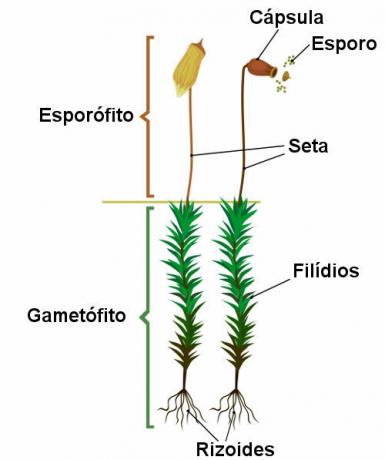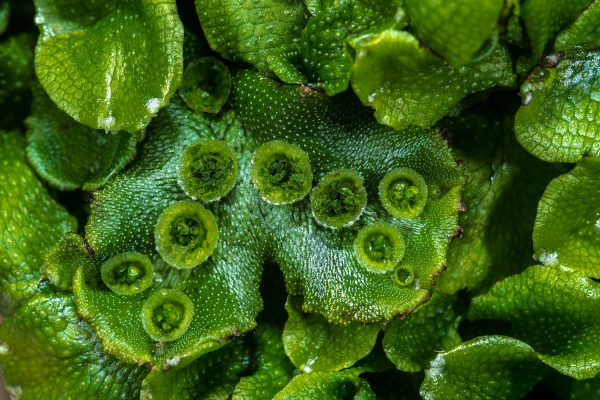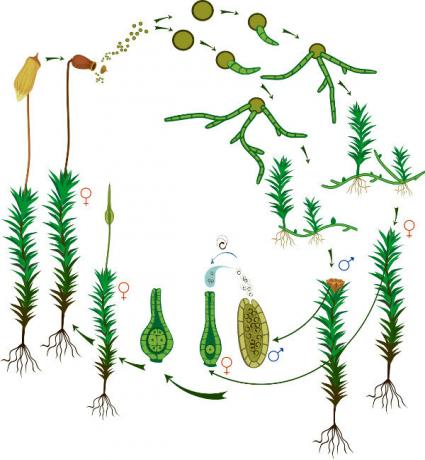At bryophytes are plants that have as one of their main characteristics the absence of sap conducting vessels, that is, they are plants called avascular. Bryophytes are generally small and are found more often in humid places, although they also occur in other regions. Next, we'll talk more about this group of plants.
Characteristics of bryophytes
Bryophytes are plants that do not have sap-conducting vessels, that is, they do not have xylem and phloem. Your dominant phase in the life cycle is the gametophyte phase, that is, the phase of the life cycle responsible for the production of gametes.
Read too: What are gametophyte and sporophyte?
Do not stop now... There's more after the advertising ;)
Bryophytes are plants from littlepostage, one of the factors that hinder its growth is the lack of conducting vessels, which makes it impossible to transport water and nutrients for very long distances. In addition, its body is very thin, which also makes it difficult to support tall plants.
Some bryophytes are called
stalks and others from hardwoods. Those called talosas do not have the gametophyte differentiated into root, stem and leaf. The hardwoods, on the other hand, have a differentiated body, however, they will not be considered true leaves and stems, since they occur in the gametophyte stage and do not have conducting vessels. We call the sheet-like structures of philids and the stem-like structure of kaolidia.
Look closely at the gametophyte and sporophyte structure of a moss.
Bryophyte gametophytes have root-like structures called rhizoids, that act helping the plant to be fix on the ground. Rhizoids differ from roots, as the latter are found in sporophytes of vascular plants and do not have specialized conductive vessels for conducting sap. In addition, rhizoids do not have the primary function of absorbing water and mineral salts, since this function is observed throughout the body of the gametophyte.
Bryophyte sporophytes arise after fertilization and are the spore-producing phase. Sporophytes remain attached to the gametophyte after its emergence and are dependent on them for nutrition. Generally, the sporophyte is differentiated in foot (which remains in the archegon of the gametophyte), arrow and capsule, with the capsule being the place where the spores will be produced. Generally, mosses and anthocerans sporophytes are larger and more complex than those present in liverworts. It is noteworthy that gametophytes are nutritionally independent from sporophytes.

It is in the capsule that the formation of spores occurs.
These plants do not have seeds, flowers or fruits. The seeds only appear in the gymnosperms, while flowers and fruits appear only in the group of plants called angiosperms.
Examples of bryophytes
Examples of bryophytes, liverworts, anthocers and the mosses, the latter being the best known. The liverworts stand out for having liver-shaped gametophytes, hence the name liver, which comes from the Latin hepaticus which means liver. Anthocerans, in turn, have this name due to the shape of the sporophyte, which is elongated and conical. The term comes from the Greek keras, which means horn.
Classification of bryophytes
Bryophytes can be classified into threephyla distinct: marchantiophyta (the livers), Bryophyta (the mosses) and Anthocerotophyta (Anthoceros). Here are some characteristics that help differentiate these three groups of bryophytes:

Liverworts are part of the Marchantiophyta phylum.
Marchantiophyta: In this group, we find liverworts, which stand out for not having stomata, a structure present in other groups.
Bryophyta: In this group, we find bryophytes with cells specialized in conduction. The cells that carry water are called hydroids, and those that carry nutrients are called leptoid.
Anthocerotophyta: A striking feature of this group is the presence of a typical basal meristem, which appears in sporophytes in the region between the foot and the capsule. This meristem allows the capsule to continue to elongate for a longer period.
Reproduction of bryophytes
Bryophytes reproduce both sexually and asexually. We can observe the reproductionasexual, for example, in some species of mosses. In this group, there is the formation of small seedlings that detach from the mother plant and form new individuals identical to the one from which they originated. Bryophytes can still reproduce from sexual way, involving, in this case, the gametes (anterozoids and oosphere).
Bryophytes, like all plant groups, have a life cycle with alternation of generations, that is, there is a gametophytic (haploid) and a sporophytic (diploid) life phase. In the gametophyte phase, the formation of gametes is observed, while in the sporophyte phase, we see the production of spores. Next, we will describe the life cycle of mosses, a known group of bryophytes.

Look closely at the life cycle of bryophytes, a cycle that involves alternating generations.
In mosses, the presence of female gametophytes and male gametophytes is observed. In the male gametophyte, the male gamete, the anterozoid. In the female gamete, the female gamete, the oosphere. Typically, archegon contains a single oosphere, while antheridium is responsible for producing multiple anterozoids.
Read too:What is antheridium and archegon?
In order to reach the oosphere, anterozoids need to swim to it, and therefore the presence of a film of water is necessary. Due to this need, bryophytes are usually found in environmentswet. The oospheres are not mobile and remain within the archegon. When the anterozoid arrives in this region, it fertilizes the oosphere.
After fertilization, the zygote forms, which divides and forms the diploid sporophyte, which is differentiated into upright, arrow and capsule. Inside the capsule, occurs meiosis and the haploid spores are formed. An interesting fact is that within the capsule of a moss, up to 50 million spores can be formed.
Once formed, the spores are released into the medium. The spores then fall into the environment and germinate when conditions are right, forming a structure called a protonema. The protonema develops and forms the haploid gametophyte that produces gametes and starts the cycle again.
Summary of bryophytes
Bryophytes are avascular plants.
Bryophytes present the gametophytes as the dominant phase of their life cycle.
Bryophyte sporophytes remain attached to the gametophyte and are nutritionally dependent on them.
Bryophytes do not have true leaves and stems.
Bryophytes do not have flowers, seeds, or fruits.
Bryophytes have a cycle with alternating generations, presenting a gametophytic phase and a sporophytic phase.
Bryophytes need water for their reproduction.
They are representatives of bryophytes, mosses, liverworts and anthocerans.
By Ma. Vanessa Sardinha dos Santos


